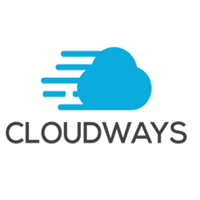The $1 Million Email Sequence You Can Benefit From Today
Have you ever run an online promotion?
There's a lot of anticipation. You come up with an offer you think your audience will be interested in, setup the sales email and hit send.
If everything goes right you'll end up with money in the bank. And sometimes it does go right.

The biggest online promotion I was involved in generated $600,000+ in a little over two weeks (that image is a screenshot of the frontend, there were three other parts to the funnel). That's an extreme. Normally the promotions we run do more like $10,000 - $20,000 over the course of five days. That's not a life changing amount of money, but it's a respectable figure.
If I had to pick out just one thing that makes these promotions successful it would be the email sequence. We've used the same sequence, with only a few variations, for every promotion.
In this article I'll break down how to run an email marketing campaign that will help generate the maximum number of sales from your promotion.
The Fundamentals of an Email Drip Campaign
An email campaign is basically a series of emails that you send in a sequence to your audience. Most campaigns have between 3-5 emails in them. These are the emails that you send to everyone.
There are lots of different drip campaigns that you can create. For example an onboarding email series might look something like this.
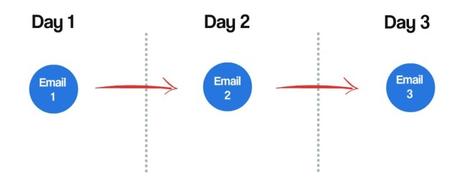
It's a pretty straight forward series of three emails. You send the emails one after the other each day.
Each of these emails has a different purpose. So you're first email is an introduction. You might ask the reader to follow you on social media or whitelist your email address. On the second day you might send them a free PDF, and so on.
An email campaign for a promotion follows this same basic formula. Just like the onboarding campaign, each of the emails is focused on something slightly different. You create anticipation, desire, and use other emotional or logical triggers to make the reader take an action.
The aim is always to get people to open the email, and click on that link.
To get the maximum number of sales, you use action based triggers within the email sequence. The way this works is intuitive. For example, you send an email to everyone on your list. Then, two-hours later you send a second email to the people who didn't open that first email.
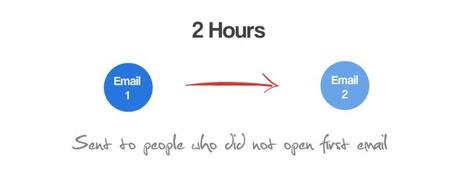
As you'd expect, some people who didn't open that first email will open the second email.
The more people who open an email, the more people click on the link. Ultimately this gets you the maximum number of sales.
Obviously you don't want to send too many emails to your audience. It's important you strike the right balance between how many opens you get, and how annoyed you want people to feel. To find the right balance we need to cover a bit of the psychology behind a promotion.
Also Read:
When to Send Your Emails
With every type of time sensitive offer the majority of the sales come in the first 48 hours, and the last 48 hours. For example, the rough rule of thumb for a successful Kickstarter campaign is that you hit ⅓ of your revenue goal within that initial 48 hours.
The same holds true, more or less, for the software promotions that we run. People are really excited about what happens at the beginning, and they're scared of missing out on the offer at the end. In the middle people aren't really interested.
I guess that's human nature.
The email sequence you create should mimic this trend. Most of the emails that you send are going to be at the start of the promo. You then do a big push at the end. In the middle you do send emails, they're just not very effective.
We've now covered when you should send your emails. So let's wrap it all up together and make it practical. Below are three types of promo campaigns you can run.
3 Easy to Run Promo Campaigns
Up to now I've just provided context. If you're used to running email marketing campaigns, then this is the bit that you really want to pay attention to. We have two rough drip email campaigns that we use for a promotion.
As a bons I'll cover how AppSumo run their email marketing campaigns. It's something not many people are aware of, and it's something you can apply to your own campaigns.
Campaign 1: The Pressure Seller
The Pressure Seller campaign is the email sequence you want to use to get the maximum number of sales from a promotion. It works really well, but you have to send a lot of emails to make all of these sales.
Like a lot.
Of course you can't send this many emails to a person all the time. You want to save this campaign for when you are getting a high conversion rate on the offer that you are promoting.
As you can see, the majority of the emails in the sequence are sent on the last day of the campaign. This is something I touched on earlier. Below is an overview of the possible subject lines for this kind of sequence. We can pretend this offer is for a logo designer called LogoMaker.
- Email 1: Cloud based logo designer with 200 templates
- Email 2: You need to see this...
- Email 3: LogoMaker $20 coupon code
- Email 4: This offer just got cheaper
- Email 5: LogoMaker - We've answered your questions
- Email 6: In case you were wondering...
- Email 7: Final recap: 12 hours left
- Email 8: (Closing soon) - 4 hours left
- Email 9: Last chance: 1 hour left
If you struggle to write good subject lines you can always use a headline generation tool to do it.
Emails two, four, and six would not need to be original content. As the person did not even open the email you could send them exactly the same email as in one, three, and five, but just change the subject line.
Make sense 😉
You can reduce the number of emails people receive by using more advanced action based tracking. The easiest way to do this is to separate the people who opened your email, but didn't click on the link to those who did. Send these people less emails.
Here's what a person who clicked on the link in your first email would receive.
You can see they get less emails. This is good, because you want to reduce the number of unsubscribes from your list.
Campaign 2: The Casual Salesman
The Casual Salesman is a nice email drip campaign for a promo. You'll get less sales than a Pressure Seller campaign, but you get less unsubscribes as well. This is what the campaign looks like.
As you can see there's still a focus on the first and last day of the promotion. You can easily expand this campaign by adding some emails to the start, and the beginning of the campaign. For example, you can do things like the following:
- Send an email up to 48 hours before the campaign to let people know you are about to run a special offer. This will create some anticipation.
- Send an email up to 24 hours before the campaign with a free giveaway, then mention that you're going to run an offer. This creates goodwill.
- Add an extension of up to 24 hours onto the end of your campaign for the people who missed out. This adds a new deadline to the offer.
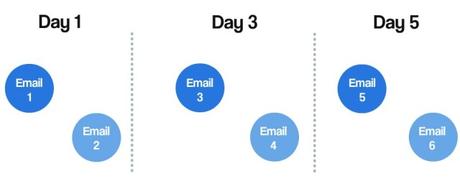
Of course if you over use these methods they become less effective. Use them occasionally and intelligently to get more sales from a promotion.
Campaign 3: The VIP Curtain
The third campaign is a very casual, but also clever, promotion. The way that this works is pretty simple. You first create an exclusive VIP group of core supporters. AppSumo use a Facebook group for this.
If you don't have a Facebook group you can create your exclusive group by asking your email list if they want to receive all of the offers you run, or only the best offers. Once you have created your core group, run a campaign exclusively to them. You use the information acquired from the campaign to improve the copy on your sales page, test the conversion rate, and validate the offer.
The only time you should run an offer to your entire list is if the conversion rate is high enough to justify a campaign. This is the strategy that AppSumo use, and although I don't have access to their sales data, I assume it's effective.
This approach will obviously reduce the number of people opting out of your list. You'll also see decent sales, because you had the chance to improve your funnel.
How to Write Sales Letters for a Drip Campaign
The headline for this article is "How We Made $1 Million From a Simple Email Campaign." To be clear, we use the Pressure Seller and Casual Salesman campaigns for our promos. I thought I'd chuck the Vip Curtain campaign into the ring to show you that there are different ways to run a promo you could be using.
Now that you have the outline of an email campaign you need to start writing emails. This is difficult. I can't teach you how to write copy in 500 words. Instead I'll share with you an example campaign. Then I'll provide you with a link you can use to get hundreds of prewritten campaigns you can use as inspiration for your own offers.
Example Promo Drip Campaign
Everything up to this stage has been a bit theoretical. Below is an example of an actual email campaign that uses the Casual Salesman approach. It's for a software promotion.
These emails were sent to people who did not click on a link. It's not a lot, and the emails are quite spread out.
- One email on the first day of the promotion (15th)
- Two emails on the last day of the promotion (18th)
- One email to notify there was a 24-hour extension (19th)
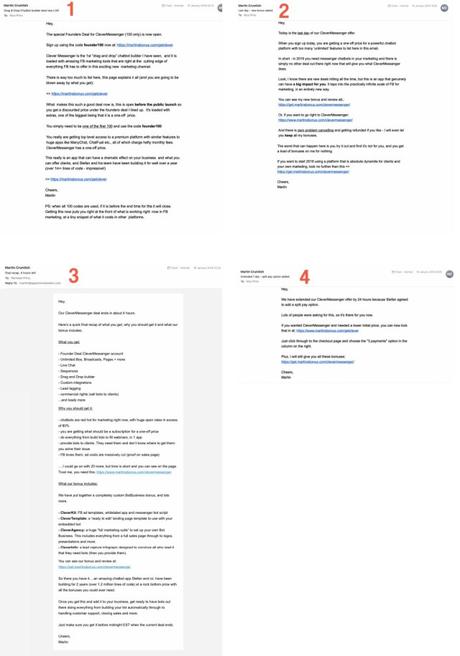
You can see that there's a strong focus at the end of the campaign. Each email also has a slightly different angle.
I'll breakdown one of the emails below, so you can see what makes the structure work so well.
It's a nice email. Simple and to the point. The tone is almost like someone talking to a friend.
Taken on its own the email is a good example of what makes a great sales letter. When combined with the other three emails in the sequence, it's a good example of what a campaign would look like. Hopefully looking at this campaign some of those things I talked about in this post are starting to come together for you.
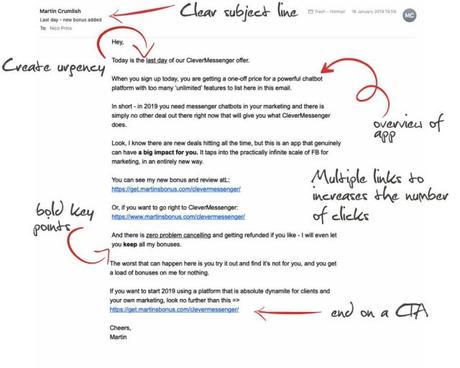
Now onto the next section.
Where to Get Endless Email Swipes
As I mentioned, learning how to write email copy is hard. It can take months or years of practice to get to become an expert. Luckily there are plenty of people who have put in that time, and practice.
Now the obvious place to get good copy for a campaign is to sign up to a couple of email lists that are relevant to your niche. The bigger the company the more likely they are to have a good copywriter.
You can also review online resources for inspiration on how to write email copy. There are great resources for email swipes, articles on what not to include in marketing emails, and a bunch more besides.
So far so obvious...
Taking it to the next step, a good place to get swipes for an email sequence is a website called Muncheye. This is a place where people who run short term software promos list their offers. The listings on the left hand side are the premium ones. These are the ones that usually have the best email swipes.
If you visit the website, click on any of these links and follow the listings through to the Joint Venture (JV) page. There are almost always free swipes on offer somewhere on the page. There are listings made every day, so there are hundreds of examples of swipe files that you can review. Check them out and adapt the best ones for your own campaign.
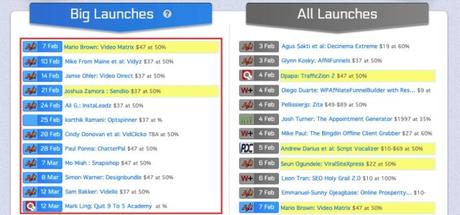
Bonus: Roping in Affiliates to Make it a Success
The final part of running a deal is getting those sales. Obviously the easiest way to do this is to hit up your own audience. However, if you don't have a large audience, and a lot of people don't, then I strongly suggest you open up your offer to affiliates.
Muncheye provides a good overview of how you can do this, and the kind of resources that you should put in place for the people you are asking to promote your offer. I'd say a JV page with all of the necessary information is a minimum.
If you're unsure what to add on a JV page I suggest you include:
- When the promotion will be held
- How much money affiliates can make
- Prize money, if you're running a competition for affiliates
- Previous information about the offer - for example conversion rates
- Email swipes for the promotion
- Bonus material that they can give to their audience to get extra sales
It is about providing the resources that make it as easy as possible for a person to support your promotion. Once you've got the resources in place you'll need to start outreach. I suggest you begin by researching how to do cold outreach. Once you've created a template that works for you it's easy to scale the campaign using blogger outreach tools.
With a good offer, and a nice cold outreach email, there will be people interested in supporting your offer. This networking can also support other aspects of your business, providing you opportunities for guest posting and other things.
Conclusion: $1M Million Email Sequence Product Launch
Hopefully this article has given you a good overview of how to run an email marketing campaign for a time sensitive promotion. What I've shared is the exact same sequence that we used on the email marketing campaigns that we run. Feel free to apply the fundamentals of the promo that I shared here to your own campaigns. Hope it helps you grow your business.
